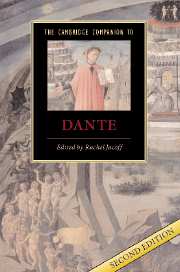Book contents
- Frontmatter
- 1 Life of Dante
- 2 Dante and the lyric past
- 3 Approaching the Vita nuova
- 4 From auctor to author: Dante before the Commedia
- 5 Introduction to Inferno
- 6 Introduction to Purgatorio
- 7 Introduction to Paradiso
- 8 Dante and the Bible
- 9 Dante and the classical poets
- 10 Allegory and autobiography
- 11 A poetics of chaos and harmony
- 12 The theology of the Comedy
- 13 The poetry and poetics of the creation
- 14 Dante and Florence
- 15 Dante and the empire
- 16 Dante and his commentators
- 17 Dante in English
- Further reading
- Index
- Series List
10 - Allegory and autobiography
Published online by Cambridge University Press: 28 May 2007
- Frontmatter
- 1 Life of Dante
- 2 Dante and the lyric past
- 3 Approaching the Vita nuova
- 4 From auctor to author: Dante before the Commedia
- 5 Introduction to Inferno
- 6 Introduction to Purgatorio
- 7 Introduction to Paradiso
- 8 Dante and the Bible
- 9 Dante and the classical poets
- 10 Allegory and autobiography
- 11 A poetics of chaos and harmony
- 12 The theology of the Comedy
- 13 The poetry and poetics of the creation
- 14 Dante and Florence
- 15 Dante and the empire
- 16 Dante and his commentators
- 17 Dante in English
- Further reading
- Index
- Series List
Summary
Among the last words spoken by Jesus in the Gospel of John are those directed to Peter, predicting the disciple's martyrdom:
Verily, verily, I say unto you that when you were young you girt yourself and walked wherever you wished; but when you are old you will stretch out your hands and another shall gird you and lead you where you would not go.
(John 21:18)In his commentary, St. Augustine explains that these verses mark the passage in Peter's life from youthful self-reliance to humility, from the sin of presumption to confession and contrition. In middle age (for Peter is neither young nor old), he is called upon to demonstrate his love by caring for the Lord's sheep and by being willing to accept crucifixion.
The conversion from presumption to humility is also the theme of Dante's descent into Hell, which likewise takes place in middle age: “nel mezzo del cammin di nostra vita.” The landscape of the prologue scene borrows several details from book 7 of Augustine's Confessions, where philosophical presumption is distinguished from confession: “it is one thing, from a wooded mountain top, to see the land of peace and quite another to reach it, when one's way is beset by the lion and the dragon.” It is likely that casting off the rope girdle halfway through the Inferno signifies a surrender of self-reliance analogous to Peter's, while the rush with which the pilgrim is girt at the beginning of the Purgatorio is a traditional emblem of humility (“umile pianta”.
- Type
- Chapter
- Information
- The Cambridge Companion to Dante , pp. 161 - 180Publisher: Cambridge University PressPrint publication year: 2007

